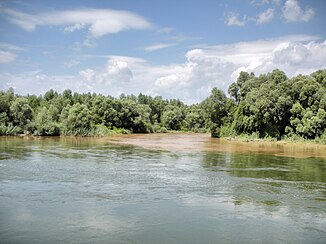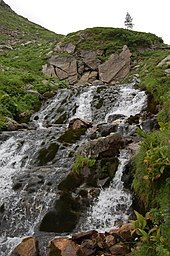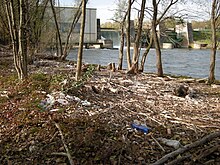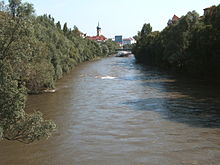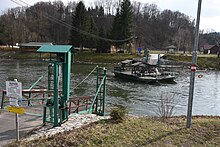Mur (river)
The Mur ( Slovenian , Croatian and Hungarian Mura ) is a river that flows through Austria , Slovenia , Croatia and Hungary and in parts of its course also forms the border between these states.
course
The Mur rises southeast of the Murtörl ( 2260 m ) in the Schmalzgrube at an altitude of about 2050 m above sea level. A. in the Ankogel Group (in the Hohe Tauern National Park ) in Salzburg's Lungau and is the only part of Salzburg to drain eastwards.
It continues to flow as the main river through Styria and its capital Graz .
In southern Styria it forms the border with Slovenia. In the further course it flows through Slovenia, then forms the border between Slovenia and Croatia and finally between Croatia and Hungary. As the last major tributary in Croatia, the Trnava flows into the Mur. After 453 km, it flows into the Drava near Legrad on the Croatian-Hungarian border . Shortly before that, the Prinzipal Canal joins it, which connects the Zala with the Mur.
nature and environment
Even on its upper reaches in Austria, the Mur was one of the most polluted rivers in Austria until the late 1980s, mainly due to wastewater from the paper industry in Pöls , Hinterberg , Niklasdorf and Gratkorn, as well as the heavy industry ( Voestalpine Donawitz ).
Today the Mur in its slowly flowing Styrian area south of Graz has been largely rehabilitated and has a satisfactory water quality, as the return of some sensitive fish species (e.g. grayling ) shows. Since then, the water quality has continuously improved. In 2014 the Mur was awarded the European River Price . In 2015 the Mur was nominated for the Thiess International Riverprice and came in second place. The renaturation was and will be continued where it is economically justifiable. Since 2002, in the upper reaches, for example, near the towns of Mauthof near Murau , Thalheim (municipality of Pöls-Oberkurzheim) and Apfelberg (municipality of Knittelfeld ), bank reinforcements have been dismantled, oxbow lakes reactivated and alluvial forests created.
In the storage space of Murkraftwerkes Gralla also numerous water birds have settled. At the observation station set up there, you can observe various species of ducks , swans and herons (such as great egrets and gray herons ). With a bit of luck you will also see a kingfisher . The damming of the river due to the hydropower plants and the raising of the groundwater level made it possible, at least in part, to re-create landscapes in the areas not used by intensive arable farming (mostly maize cultivation) that are at least similar to the floodplain landscape before the regulatory measures. To 1979 in one of these riparian forests in the market town was Gössendorf the sewage treatment plant of the city of Graz built. Every day around 75,000 m³ of treated wastewater flows into the river. The system, which is currently designed for a population equivalent of 500,000 , has been able to significantly improve the water quality downstream of the state capital.
Adjacent to the river, where there is no agricultural use of the adjacent areas, there are wet meadows or alluvial forest. The typical plant species, such as marsh marigolds , can be found in the meadows or wooded areas next to the Mur (e.g. at the level of the Gabersdorf river power station).
use
Hydropower plants
There are currently the following hydropower plants on the Mur; 21 of these are operated by Verbund AG . In the direction of flow these are:
| Surname | operator | (1.) Commissioning | Power (MW) |
Annual generation ( million kWh) |
local community |
|---|---|---|---|---|---|
| Murfall | Salzburg AG | 1922 | 0.78 | 3.7 | Muhr, State of Salzburg |
| Bodendorf-Paal | Verbund AG | 1982 | 27 | 86 | St. Georgen am Kreischberg , Styria |
| Bodendorf-Mur | Composite | 1982 | 7th | 34 | St. Georgen am Kreischberg |
| St. Georgen | Composite | 1985 | 6th | 32 | Sankt Georgen ob Murau |
| Murau | Murauer Stadtwerke | 1908 | 4.5 | 22nd | Murau |
| Fishing | Composite | 1994 | 22nd | 74 | Weißkirchen in Styria |
| Leoben | Composite | 2005 | 10 | 50 | Leoben |
| Niklasdorf | MeinAlpenStrom GmbH | 1895 | 5 | 19th | Niklasdorf |
| Dionyses | Composite | 1949 | 16 | 85.9 | Oberaich |
| Bruck an der Mur | Stadtwerke Bruck an der Mur | 1903 | 3 | ? | Bruck an der Mur |
| Pernegg | Composite | 1927 | 22nd | 121.4 | Pernegg on the Mur |
| Laufnitzdorf | Composite | 1931 | 18th | 121 | Laufnitzdorf |
| Frohnleiten | MeinAlpenStrom GmbH | 1925 | 10 | 47 | Frohnleiten |
| Rabenstein | Composite | 1987 | 14th | 64.5 | Frohnleiten |
| Peggau | Composite | 1908 | 13 | 84.2 | Peggau |
| Friesach | Composite | 1998 | 12 | 60 | Peggau |
| Weinzödl | Composite | 1982 | 16 | 63 | Graz |
| Graz-Puntigam | Energy Styria | 2019 | 16 | 74 | Graz |
| Gössendorf | Composite | 2012 | 19th | 88.6 | Gössendorf |
| Kalsdorf | Composite | 2013 | 19th | 81.2 | Kalsdorf near Graz |
| Mellach | Composite | 1985 | 16 | 74 | Mellach |
| Weissenegg | Composite | 1985 | 1 | 5.7 | Werndorf |
| Lebring | Composite | 1988 | 20th | 83.9 | Lebring |
| Gralla | Composite | 1964 | 15th | 71.8 | Gralla |
| Gabersdorf | Composite | 1974 | 14th | 68 | Gabersdorf |
| Obervogau | Composite | 1978 | 13 | 60 | Obervogau |
| matchfield | Composite | 1982 | 13 | 67 | matchfield |
The construction of the following power plants is planned:
- Stübing power plant , in Kleinstübing (planned, 12 MW, 57,800 MWh / a)
- Gratkorn power plant , in Gratkorn (approved but not under construction, 11 MW, 54,200 MWh / a)
One in June 2010 as part of the environmental assessment process created report confirms that the project for the barrage Gratkorn negative impact on the fish population. It is noteworthy that the report by the water ecologist Clemens Gumpinger was not commissioned by opponents of the project, but by Verbund AG , the project applicant himself.
After completion, 21 species of fish can be expected to largely disappear . In addition to the already on the endangered Red List species contained Danube salmon would grayling and Strömer most affected. The planned fish ladders could be overcome by the fish, but they would only get into the next storage area. However, many fish species in the Mur need flowing water to reproduce.
The WWF and other nature conservation institutions distanced themselves from the seamless expansion of hydropower on the Mur and instead demanded that the existing savings potential for space heating, hot water, lighting and transport be used, as well as the expansion of other renewable energy sources such as wind, biomass and solar energy.
Grazer Mühlgang
Today the Graz-Weinzödl power plant (built in 1982) has a small power plant on its right bank. The Mühlgang runs through the state capital and runs over Feldkirchen to Großsulz near Kalsdorf for a total of 23 km. He communicates with various streams. The Schleifbach, a diversion from the Mühlgang below the Gösting power station, used to power mills from knife grinders and in 2017 was piped over its entire length (2.2 km) (1.2 m diameter) to feed a small power station on the right bank of the Mur.
The Mühlgang drives about a dozen small power plants, where (in Graz :) from 1270 at the earliest until the beginning of 2014 ( Rösselmühle ) at the latest, mills were previously operated. The wooden mill wheel on the slope of the former Tagger mill, which has been standing still since 2005, was lifted out in 2016/2017 after its wooden axis was sawed. A stream for river surfing has been set up in the bypass channel of this mill. There is a paddle slalom training course on the first 100 m, a surge for paddling acrobatics at the Puchstrasse roundabout.
Before and after the Schlossberg there were formerly two mill passages on the left bank in Graz, these were shut down decades ago, the upper one in Geidorf around 1977.
water sports
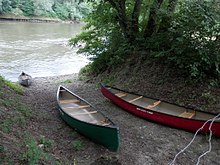
Especially in Graz and here again just below the Erzherzog-Johann-Brücke and the Radetzkybrücke, athletes surf with a board or paddle boat in standing waves, which are formed by stones at favorable water levels. In 2003 the paddle rodeo world championship took place at the (then still :) main bridge . A boathouse in the center at Marburgerkai was probably used in historical times for embarking and disembarking rowboats. In 2014 the boathouse of a new rowing club was put into operation in what is now the dam area of the Gössendorf power plant on the southern outskirts of the city on the left bank. On the right bank a little above there has been a paddle boat rental since 2014. Around 2008 the Graz fire brigade removed steel girders that had stood up a piece from the ground for decades as the remains of an auxiliary support under the railway bridge in the middle of the river. In January 2012, activists from Rettet die Mur , a citizens' initiative that campaigns against another Mur power plant in Graz, fished out iron scrap at the lowest water level for many years at the Graz Augarten to make the river safer for athletes.
Ship mills on the Mur



Are located in the Mur today three of the now grown rare ship mills , floating on the water and towards the shore moored barges that have a double hull connected by beams and between which a water wheel by the river flow undershot is driven.
The first of the three ship mills on the Mur is located in Mureck , between Spielfeld and Bad Radkersburg on the Slovenian border. She ran aground in winter 2005/06 and u. a. Sank during the floods in 2012. After the original version has been completely lost, today's is an authentic replica and is an attractive point of attraction for visitors. An association takes care of the preservation.
The second mill can be found downstream in Slovenia near Veržej , north of Ljutomer. Known as "Babič-mlin", it is an original mill whose water wheel with gear floats on the water while the mill house stands on the river bank. The power transmission to the land takes place via a cable drive. The mill is privately owned and is a popular destination for tourists from the area.
The third ship's mill is an authentic replica of a type that was often found on the Mur. It is located a little upstream from Mursko Središće in the triangle of Slovenia, Croatia and Hungary on the Croatian bank. As in Mureck, the pontoon on the shore carries the mill house, while the float on the river side carries the counter bearing of the mill wheel. There is another ship mill on the Mur, but as a wreck in the dry on the site of the thermal bath in Lendava , Slovenia.
Cycle path
A 365 km long cycle path , the Mur cycle path , runs through Salzburg and Styria along the Mur . Bicycles also take place here, there is running and inline skating.
Others
In Croatia, the area between the Mur and Drava is referred to as "Zwischenmurland" (Croatian Međimurje ) or in German also as "Murinsel". Today Međimurje is one of the 20 counties in Croatia with the capital Čakovec . The Mur also forms the border between two historical Slovenian countries: Lower Styria (Štajerska) and Prekmurje , which is known in German as the “Übermurgebiet”. Today the Prekmurje and the Styrian Prlekija form the Slovenian Pomurska ("Murgebiet" or "Murland") with the capital Murska Sobota .
Web links
Individual evidence
- ↑ Federal Ministry of Agriculture, Forestry, Environment and Water Management (ed.) : List of areas of the Austrian river basins: Mur area. Contributions to Austria's Hydrography, Issue No. 60, Vienna 2011, p. 119 ( PDF; 4.5 MB ( Memento of the original from October 12, 2013 in the Internet Archive ) Info: The archive link was automatically inserted and not yet checked. Please check Original and archive link according to instructions and then remove this note. )
- ↑ Federal Ministry for Agriculture, Forestry, Environment and Water Management (Ed.): Hydrographisches Jahrbuch von Österreich 2011. 119th Volume. Vienna 2013, p. OG 320, PDF (12.9 MB) on bmlrt.gv.at (yearbook 2011)
- ↑ 120 years Murkommission , p. 32.
- ^ Ed. Hölzel : Upper School Atlas (1981).
- ↑ a b Günter Pilch: How the Mur was transformed from a sewer into a model river. Kleine Zeitung, September 23, 2015, accessed April 25, 2018 .
- ↑ Thiess International Riverprice (English) - Finalists 2015 ( Memento of the original from June 27, 2015 in the Internet Archive ) Info: The archive link was inserted automatically and has not yet been checked. Please check the original and archive link according to the instructions and then remove this notice. Retrieved August 3, 2015
- ↑ Karin Hirschmugl: All right with the Graz wastewater. In: BIG - The official pages of the City of Graz , April 2018 edition, pp. 8–9.
- ^ H. Kainz, G. Maurer & E. Tschaussnig: Planning and expansion of the Graz sewage treatment plant. In: Österreichische Wasser- und Abfallwirtschaft , 57th volume, issue 5/6 (May / June 2005), pp. 63–70, doi: 10.1007 / BF03169026 .
- ↑ The Mur. Verbund AG , accessed on September 12, 2016 .
- ↑ Obervogau run-of-river power station. Verbund AG, accessed on September 12, 2016 .
- ↑ Note. The Lungau power plant group includes three other power plants: Rotgülden power plant with Plölitzenspeicher, ...
- ↑ Muhr National Park Community > Murfall Power Plant muhr-tourismus.at, accessed March 8, 2020.
- ↑ Dr. Krauss ZT GmbH> Wasserbau> Flusskraftwerke krauss.g03.net, accessed March 8, 2020.
- ↑ Power plants. January 10, 2017, accessed January 10, 2017 .
- ↑ Power plants. www.meinalpenstrom.at, accessed on September 12, 2016 .
- ↑ kleinezeitung.at - Mur power plants threaten fish stocks. Accessed June 6, 2010
- ↑ Factsheet The Myth of Hydropower (pdf; 137 kB) WWF. May 13, 2011. Archived from the original on May 13, 2011. Retrieved on May 13, 2011.
- ↑ The myth of hydropower brochure (pdf; 5.7 MB) WWF. May 13, 2011. Archived from the original on May 13, 2011. Retrieved on May 13, 2011.
- ↑ Power plant projects : WWF fears for huchen . ORF. February 16, 2011. Archived from the original on May 13, 2011. Retrieved on May 13, 2011.
